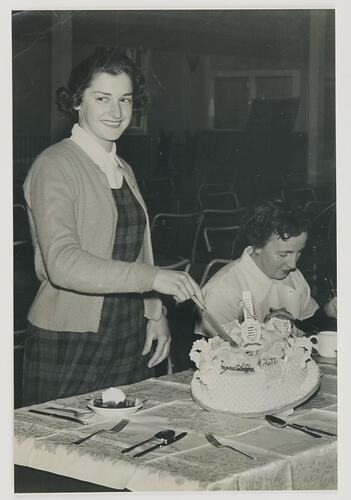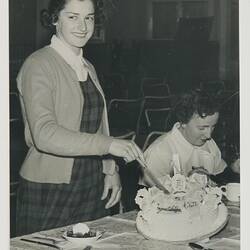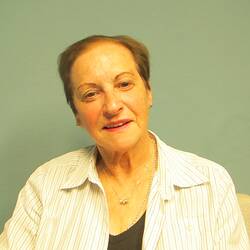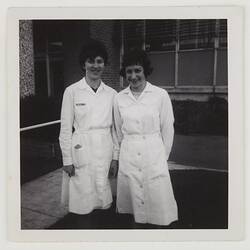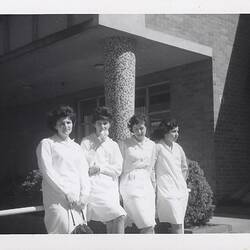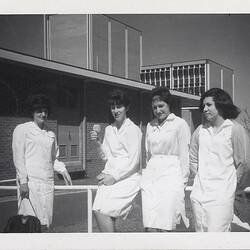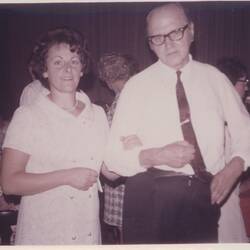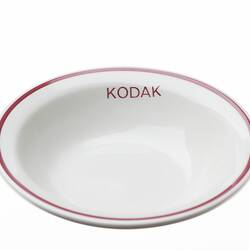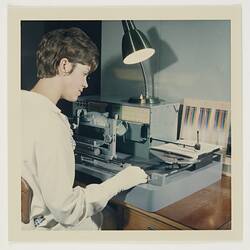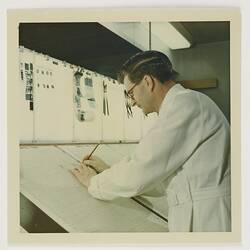Summary
From secretary to densitometry operator, 1956-1966.
Betty Radstake, Kodak Australasia Pty Ltd: Secretary, Canteen Cashier, Densitometer Operator 1956 - 1966
Betty Radstake (née Silcock) left school at the age of 14 and worked in several different jobs. One job was in the main trunk telephone exchange in Bourke Street Melbourne. She didn't like working shifts at the exchange, so in 1956 she applied for a position at Kodak. Her job was secretary/girl friday to both Eddie Sharkey, the canteen manager, and Ray Hull, who was in charge of waste film. Both jobs were located in a building known as 'the cottage' or Yarra Grange cottage at Kodak's Abbotsford plant. Betty liked the friendly, family atmosphere at Abbotsford.
The canteen
Betty's job with the canteen manager involved ordering food supplies, typing the menus and serving as a cashier during lunchtime when the canteen was very busy. Betty remembers that it served good cheap food, including hot meals, salads, sandwiches and cakes. A popular dish on Monday's menu was 'Vienna steak', made of mincemeat. The canteen also sold sweets. People could buy cigarettes from Sharkey, who kept them in a cabinet in the office. Betty remembers the canteen as a meeting place for staff:
'Everyone used to come. Some people didn't buy their meal, they just used to come and have their lunch there. It was a place to gather - people from all the departments just used to gather there for lunch. But some people used to go and sit down by the Yarra, because just down from the canteen was the river.'
Betty particularly remembers the day of her 21st birthday when the canteen staff gave a lunch for her. Tony Smarelli, one of the canteen cooks, made a birthday cake. Betty recalls:
'It was such a surprise. But it was so nice, and that's what I mean about Kodak. It was just like a family. It was great.'
Office work
Betty's duties in the waste survey department included typing the weekly report on waste film - that is, film that had been damaged during manufacture and could not be sold. She remembers office work in the 1950s, well before photocopiers and computers, and even before electric typewriters. To make copies of documents, she typed a stencil on a manual typewriter and put it on a Gestetner duplicating machine:
'You know, roll off, fit it onto the machine, press a little button to make sure there was plenty of ink in the thing and then turn a handle, and run it off however many copies I had to give to the different departments.'
It was Betty's job to hand out the copies and run messages for her bosses. Betty continued working at Kodak after her marriage, when she became Betty Parkes. When she resigned to have her first baby in 1961, Betty received a good reference.
Returning to Kodak - at Coburg
In 1963 Betty was ready to return to work:
'I always thought what a great time it was working at a Kodak. And I saw an advert for a position at the factory in Coburg, and that was a new factory just opened up. So I applied and I got the position.'
Betty found the new Coburg plant quite different from the old Abbotsford factory. For a start, there was security at the Coburg gate, whereas at Abbotsford anyone could come in or go out. Also:
'At Abbotsford it was like a big family. Everyone knew everyone. But at Coburg it was a little different. It was much bigger - and new staff. Not everyone went from Abbotsford to Coburg. But some of them did, and I knew them.'
Densitometry operator
Betty's new position at Coburg was a densitometry operator in the Testing Department in Building 7. Her job was to read samples of film exposed to controlled light for different periods of time, to ensure that the film met the standard for the speed of exposure it was intended for. Betty would plot the results by hand and draw up a graph, which was interpreted by the product supervisor. This was part of Kodak's quality control system. Betty remembers that in the 1960s a lot of film was found to be below standard and rejected before it left the factory. Many years later, in the 1980s, Kodak embarked on the Total Quality Control program, which reduced the amount of film that was rejected.
In 1966 Betty left work because she was expecting her second baby. She has happy memories of Kodak.
References
Beale, Nigel, 'The History of Kodak in Australia', 1983 (unpublished manuscript).
HT 38581 - Oral History with Betty Radstake, interviewed by Lesley Alves 13 November 2014.
More Information
-
Keywords
Manufacturing, Photographic Products, Biographies, Managers, Marketing
-
Localities
-
Authors
-
Article types
